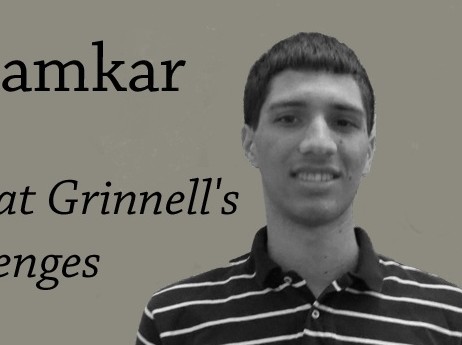
On February 23, the Grinnell College Board of Trustees voted to maintain Grinnell’s commitment to need-blind admission and meeting 100% of demonstrated need by adopting a new revenue model. By increasing net tuition revenue and philanthropic support, the Board expressed hope that Grinnell would find itself on sound financial footing. The Board also approved an increase in the comprehensive fee. While these adjustments will hopefully resolve Grinnell’s short-term financial difficulties, Grinnell—and the rest of the higher-education sector—faces significant long-term challenges to its funding model.
Though Grinnell recently engaged in a prolonged discussion over how to fund itself, the current dialogue did not include the College’s underlying cost and delivery model. The administration truthfully pointed out that a liberal arts education is expensive, excessive cutting is detrimental to institutional excellence, and Grinnell’s costs compare favorably with those of peer institutions. But this line of thinking ignores the uncomfortable reality that all higher education institutions are facing cost structure problems. College tuition and fees have risen 1,120 percent since 1978, which is approximately four times the rate of inflation.[i] Even though the returns on a college degree remain high, there are myriad reasons to believe that higher education costs cannot increase forever.
Moody’s Investors Services, a credit rating agency, recently placed the entire U.S. higher education sector on negative outlook. In a detailed report that received substantial media coverage, Moody’s identified a combination of mounting fiscal pressure on all university revenue sources and external factors for the downgrade: “[M]ost universities will have to lower their cost structures to achieve long-term financial sustainability and fund future initiatives.”[ii] The report projects that tuition, endowments, philanthropy and federal spending on student aid are unstable and likely to diminish.[iii] This is attributable to many reasons, including high unemployment, fewer high school graduates, slow economic growth, uncertain federal spending and political gridlock.3 These factors all reduce the pricing power of universities, and therefore their ability to raise costs.
A key reason that colleges have been able to raise costs so drastically is that the federal government heavily subsidizes the higher education sector. Last year, the federal government distributed approximately $174 billion worth of aid in the form of grants, loans, work-study and tax credits.[iv] This represents a 140% increase since 2001.4 Of the total $185.1 billion in undergraduate student aid that was distributed last year, 73% came from the federal government.4 The popular Pell grants, which are awarded to low-income students and do not need to be repaid, totaled $34 billion and were awarded to 9.4 million students last year.4 The takeaway: colleges rely extensively on federal grants and loans to fund themselves.
This source of funding is in serious jeopardy for several reasons. The first is that political gridlock has thrown all federal budgeting in jeopardy. Federal aid is caught in the middle of Washington’s tax and spend debate, with Republicans in particular attempting to cut Pell grants.[v] But the pressure is bipartisan. In his recent State of the Union Address, President Obama threatened to reduce taxpayer funding of higher education unless colleges limit the rate of tuition increases.[vi] There have also been calls for institutions to provide more transparency about the post-graduate success of their students, especially in terms of employment and salary data. With total student loan debt outstanding surpassing $1 trillion in late 2012[vii] and the default rate on student loans at its highest level since 1996, it is only a matter of time before grants and loans will become less accessible to students. Grinnell would find itself quite exposed if this happened, as approximately 21% of Grinnell students received Pell grants during the 2010-2011 academic year.
Perhaps the most radical challenge to traditional college funding models comes from the development of online education. Massive Open Online Courses (MOOCs), which are created by for-profit companies like Udacity and Coursera, and nonprofits like EdX, have recently emerged as viable low-cost alternatives to certain higher education courses. It is unlikely that MOOCs will ever fully replace a traditional college education. But as MOOCs become more sophisticated and receive accreditation (some have even been approved for college credit[viii]), the higher education industry will undoubtedly transform.
Grinnell’s existing funding model may come under stress in the long-term because it relies on revenue sources that will stagnate and shrink. The few (but hardly exhaustive) reasons outlined in this article suggest that Grinnell, along with its peer institutions, will eventually be forced to rethink the cost and delivery model through which it provides its “product”—an outstanding liberal arts education. Ultimately, such changes will be far more significant than any Grinnell has confronted thus far.
-Ishan Bhadkamkar
[i] http://www.bloomberg.com/news/2012-08-15/cost-of-college-degree-in-u-s-soars-12-fold-chart-of-the-day.html
[ii] http://www.moodys.com/research/Moodys-2013-outlook-for-entire-US-Higher-Education-sector-changed–PR_263866
[iii] http://www.insidehighered.com/news/2013/01/17/moodys-report-calls-question-all-traditional-university-revenue-sources





























































Reality • Mar 3, 2013 at 4:45 pm
The most thoughtful and rationale of your columns…
The solution lies in mission-creep and institutions getting away from their whole point of educating students. You can’t argue that everything that colleges do now is as critical to their mission as other things. Popular as they might be, things like a prize, prison education, even cookies at 101 talks and take a professor to lunch intrinsic value far below classes, internships, research, and study abroad. The answer has to be a return to fewer feel-good programs and more mission-central offerings.